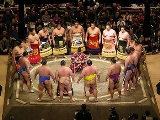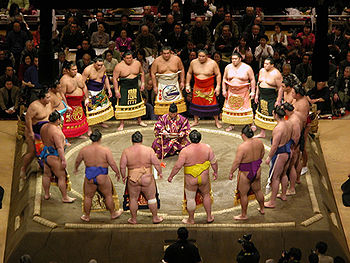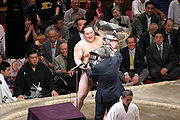
2005 in sumo
Encyclopedia
Tournaments
- Hatsu bashoHonbashoA is an official professional sumo tournament. There are six held each year, a system established in 1958. Only honbasho results matter in determining promotion and relegation for rikishi ....
, Ryogoku KokugikanRyogoku Kokugikan, also known as Sumo Hall, is an indoor sporting arena located in the Ryōgoku neighborhood of Sumida, one of the 23 wards of Tokyo in Japan, next to the Edo-Tokyo Museum. It is the third building built in Tokyo associated with the name kokugikan. The current building was opened in 1985 and has a...
, TokyoTokyo, ; officially , is one of the 47 prefectures of Japan. Tokyo is the capital of Japan, the center of the Greater Tokyo Area, and the largest metropolitan area of Japan. It is the seat of the Japanese government and the Imperial Palace, and the home of the Japanese Imperial Family...
, 9 - 23 January - Haru basho, Osaka Prefectural Gymnasium, OsakaOsakais a city in the Kansai region of Japan's main island of Honshu, a designated city under the Local Autonomy Law, the capital city of Osaka Prefecture and also the biggest part of Keihanshin area, which is represented by three major cities of Japan, Kyoto, Osaka and Kobe...
, 13 - 27 March - Natsu basho, Ryogoku Kokugikan, Tokyo, 8 - 22 May
- Nagoya basho, Aichi Prefectural GymnasiumAichi Prefectural GymnasiumThe is an all purpose gymnasium in Aichi, Japan, built in 1964. Located on the site of the secondary enclosure of Nagoya Castle, it is host to numerous concerts and events...
, Nagoya, 10 - 24 July - Aki basho, Ryogoku Kokugikan, Tokyo, 11 - 25 September
- Kyushu basho, Fukuoka International Centre, KyushuKyushuis the third largest island of Japan and most southwesterly of its four main islands. Its alternate ancient names include , , and . The historical regional name is referred to Kyushu and its surrounding islands....
, 13 - 27 November
January

- 9: The New Year tournament in Tokyo begins with Emperor Akihito and Empress Michiko among a sell-out crowd. Attention is focused on ozeki KaioKaio HiroyukiKaiō Hiroyuki is a former professional sumo wrestler from Nōgata, Fukuoka, Japan.He made his debut in 1988, reaching the top makuuchi division in 1993. He held the second highest rank of ōzeki or champion for eleven years from 2000 to 2011, and is the longest-serving ozeki of all time in terms of...
, who after winning the September 2004 tournament and finishing runner-up in November, still has a chance of yokozuna promotion. He is however, reportedly in poor condition. - 18: Kaio, with five losses already, decides to withdraw due to left shoulder trouble.
- 23: Yokozuna Asashoryu wins the tournament with an unbeaten 15-0 record for his 10th championship. His victory had been decided on the 13th day. New komusubi Hakuho finishes runner-up, four wins behind, on 11-4 and is awarded the Technique Prize. Sekiwake Tochiazuma returns to the ozeki rank after also scoring 11. He had lost his ozeki status after being injured during the previous two tournaments. It is the second time he has regained his ozeki status in this way and he becomes the first wrestler to achieve it more than once. Takekaze, Tochisakae and Harunoyama all miss the tournament though injury and lose their top division status. Kotoshogiku and Tokitenku are also demoted. In the second highest juryo division, Otsukasa wins his second championship and returns to the top makuuchiMakuuchior is the top division of professional sumo. Its size is fixed at 42 wrestlers , ordered into five ranks according to their ability as defined by their performance in previous tournaments....
division. Chiyohakuho wins the makushita division championship. Future top division stars Tochiozan, Goeido and Toyohibiki all make their professional debuts, fighting under their family names.
March
- At the Haru basho in Osaka, Asashoryu continues his championship streak with a 3rd consecutive yushoYushoA Yūshō is a tournament championship in sumo. It is awarded in each of the six annual honbasho or official tournaments, to the wrestler who wins the most number of bouts. Yūshō are awarded in all six professional sumo divisions...
, and 11th overall, with a 14-1 record. Tochiazuma, who scores 10-5, is the only man to defeat him. Maegashira Tamanoshima is runner-up on 12-3 and gets the Fighting Spirit Prize. Veteran former komusubi KaihoKaiho RyojiKaihō Ryōji is a former sumo wrestler from Aomori, Japan. His highest rank was komusubi. An amateur champion at Nihon University, he entered professional sumo in 1996. He was one of the lightest sekitori wrestlers in recent years. He won two special prizes for Technique...
scores eleven and receives his second Technique Prize, which he shares with AmaAma KoheiHarumafuji Kōhei , previously known as Ama Kōhei, is a sumo wrestler. He began his professional career in 2001 and reached the top makuuchi division in 2004. A relative lightweight noted for his technical skill, he has won ten special prizes for his achievements in tournaments...
. New sekiwake Hakuho, the second youngest man ever after TakanohanaTakanohana Kojiis a former sumo wrestler from Suginami, Tokyo, Japan. He was the 65th man in history to reach sumo's highest rank of yokozuna, and he won 22 tournament championships between 1992 and 2001, the fifth highest total ever...
to reach the third highest rank, gets his majority of wins with 8-7. Kotoshogiku makes an immediate return to the top division after winning the juryo championship with a 13-2 record. Former maegashira Wakakosho retires. - Oshiogawa stable shuts down, with its stablemaster and wrestlers moving to Oguruma stableOguruma Stableis a stable of sumo wrestlers, one of the Nishonoseki group of stables. In its modern form it dates from 1987 when it was founded by Kotokaze, a former Sadogatake stable wrestler. He gives all his new recruits shikona with the suffix "kaze" , taken from his own fighting name. The first wrestler...
. - Promotions to the juryo division for the May tournament are announced. Amongst them is the 34 year old Dewanosato, who began his sumo career in 1986. The 114 tournaments it took him to reach juryo is the most in sumo history.
May

- At the Natsu basho in Tokyo, Asashoryu achieves an undefeated record in his continuing championship streak, taking his 12th overall. Runner-up is komusubi Kotomitsuki who scores 13-2 and wins his sixth Technique Award. Tochiazuma finishes with a fine 12-3 record. Chiyotaikai, who was kadoban (in danger of demotion from ozeki) for the seventh time, tying Konishiki's record, wins ten. Kaio drops out through injury again. Kyokushuzan and Futeno each win their first Fighting Spirit prize. Tochisakae wins the juryo championship, and Ushiomaru the makushita championship. Former makuuchi veterans Kotoryu and Asanowaka retire.
July
- At the Nagoya basho, Asashoryu takes the tournament with a 13-2 record, and wins five consecutive championships for the first time. It is his 13th overall win. During the tournament he is defeated by new komusubi Kotoōshū of BulgariaBulgariaBulgaria , officially the Republic of Bulgaria , is a parliamentary democracy within a unitary constitutional republic in Southeast Europe. The country borders Romania to the north, Serbia and Macedonia to the west, Greece and Turkey to the south, as well as the Black Sea to the east...
, who finishes as runner-up on 12-3 and is awarded the Outstanding Performance Prize, and KokkaiKokkai FutoshiKokkai Futoshi is a professional sumo wrestler from Georgia. He began his career in May 2001. He is the first Caucasian rikishi to reach sumo's highest division, makuuchi, which he achieved in 2004. His highest rank has been komusubi, which he reached in 2006...
of GeorgiaGeorgia (country)Georgia is a sovereign state in the Caucasus region of Eurasia. Located at the crossroads of Western Asia and Eastern Europe, it is bounded to the west by the Black Sea, to the north by Russia, to the southwest by Turkey, to the south by Armenia, and to the southeast by Azerbaijan. The capital of...
, who gets the Fighting Spirit Award. Chiyotaikai and Hakuho both withdraw through injury, but Kaio preserves his ozeki status with a 10-5 score. Futeno also wins ten and receives the Technique Award as well as promotion to the sanyaku ranks next time. Tokitsuumi wins the juryo division championship and returns to the top division.
September
- At the Aki basho in Tokyo, Asashoryu wins his sixth consecutive championship, tying TaihoTaiho KokiTaihō Kōki is the 48th Yokozuna in the Japanese sport of sumo wrestling. He is generally regarded as the greatest sumo wrestler of the post-war period. He became a yokozuna in 1961 at the age of 21, the youngest ever at the time, and he won a record 32 tournaments between 1960 and 1971...
for this distinction (who managed it on two separate occasions). The championship is closely contested, however, as sekiwake Kotooshu wins his first twelve matches while Asashoryu suffers defeats to new komusubi Futeno on Day 1 (his first ever opening day loss as a yokozuna) and to Aminishiki on Day 11, to trail Kotooshu by two on 10-2. However, Asashoryu is victorious when they meet on Day 13, and Kotooshu suffers a second straight defeat to Kisenosato on Day 14. When both men finish on 13-2 on the final day Asashoryu wins the resulting playoff to claim his 14th championship. Kotooshu receives the Fighting Spirit prize for his efforts and is told that another good performance in November will give him promotion to ozeki. Kisenosato also gets the Fighting Spirit prize, his first sansho. Kaio withdraws early once again. Kaiho misses the tournament and drops to juryo. Toyonoshima wins the juryo championship with a 14-1 record and returns to makuuchi. Wakakirin wins the makushita championship. In the jonidan division, 17 year old Russian Wakanoho wins the yusho. Former komusubi Wakanoyama, who began his career in the same tournament as TakanohanaTakanohana Kojiis a former sumo wrestler from Suginami, Tokyo, Japan. He was the 65th man in history to reach sumo's highest rank of yokozuna, and he won 22 tournament championships between 1992 and 2001, the fifth highest total ever...
, WakanohanaWakanohana Masaruis a former sumo wrestler from Tokyo, Japan. As an active wrestler he was known as Wakanohana III Masaru , and his rise through the ranks alongside his younger brother Takanohana Koji saw a boom in sumo's popularity in the early 1990s...
and AkebonoAkebono Tarois a retired American born-Japanese sumo wrestler from Waimānalo, Hawaii. Joining the professional sport in Japan in 1988, he was trained by pioneering Hawaiian sumo wrestler Takamiyama and rose swiftly up the rankings, reaching the top division in 1990...
in March 1988, retires.
October
- 7-10: The Sumo Association holds a three day exhibition tournament in Las VegasLas Vegas, NevadaLas Vegas is the most populous city in the U.S. state of Nevada and is also the county seat of Clark County, Nevada. Las Vegas is an internationally renowned major resort city for gambling, shopping, and fine dining. The city bills itself as The Entertainment Capital of the World, and is famous...
. Roughly 25,000 spectators attend.
November
- At the Kyushu basho, Asashoryu wins the tournament and achieves a "triple crown" of three all-time records: seven straight championships, winning 84 out of 90 regulation bouts contested in one year, and pulling off a Grand Slam - the first time a rikishi has won all six tournaments in a calendar year. His only defeat in this basho is to Kotooshu who is runner-up alongside Chiyotaikai and Tochinohana with a score of 11-4. He wins the Outstanding performance and Fighting Spirit prizes, and more importantly promotion to ozeki. Kotooshu is the fifth foreigner, and first European, to reach the second highest rank. Tochinohana and Miyabiyama also share the Fighting Spirit prize, while Tokitenku wins the Technique award. Kotooshu's stablemaster, former yokozuna Kotozakura, reaches the mandatory oyakata retirement age of 65 on the 14th day and is immediately replaced as head of the Sadogatake stableSadogatake stableis a stable of sumo wrestlers, one of the Nishonoseki group of stables. In its modern form it dates from September 1955, when it was set up by former komusubi Kotonishiki Noboru. Former yokozuna Kotozakura took over the running of the stable in 1974 following Kotonishiki's death. Over the next...
by his son-in-law Kotonowaka, who announces his retirement from active competition at the age of 37 after 21 years in sumo and 90 top division tournaments. Former maegashira Yotsukasa and Gojoro also retire, Yotsukasa after losing 14 straight bouts in the juryo division, and Gojoro after falling to makushita 55 through injury. The juryo yusho goes to veteran TokiToki SusumuTōki Susumu is a former sumo wrestler from Ichikawa, Chiba Prefecture, Japan. His highest rank was komusubi. He is now a sumo coach.-Career:Tōki began his career in January 1991 after joining the Takasago stable...
. By contrast, the makushita and sandanme championships are won by youngsters Sawai, now Goeido, and Kageyama, now known as Tochiozan.
Deaths
- 30 May: former ozeki TakanohanaTakanohana KenshiTakanohana Kenshi 貴ノ花健士 was a sumo wrestler from Hirosaki, Aomori Prefecture, Japan. His highest rank was ozeki, which he held for fifty tournaments. As an active rikishi he was extremely popular and was nicknamed the "prince of sumo" due to his good looks and relatively slim build...
, father of Takanohana IITakanohana Kojiis a former sumo wrestler from Suginami, Tokyo, Japan. He was the 65th man in history to reach sumo's highest rank of yokozuna, and he won 22 tournament championships between 1992 and 2001, the fifth highest total ever...
and Wakanohana IIIWakanohana Masaruis a former sumo wrestler from Tokyo, Japan. As an active wrestler he was known as Wakanohana III Masaru , and his rise through the ranks alongside his younger brother Takanohana Koji saw a boom in sumo's popularity in the early 1990s...
and former head of Futagoyama stableTakanohana stableis a stable of sumo wrestlers, formerly one of the Nishonoseki group of stables. It was known as Futagoyama stable until 2004.-History:Futagoyama stable was established in 1962 by former Yokozuna Wakanohana Kanji I, who branched off from Hanakago stable and converted his home near the Minami...
, dies of mouth cancer aged 55.

